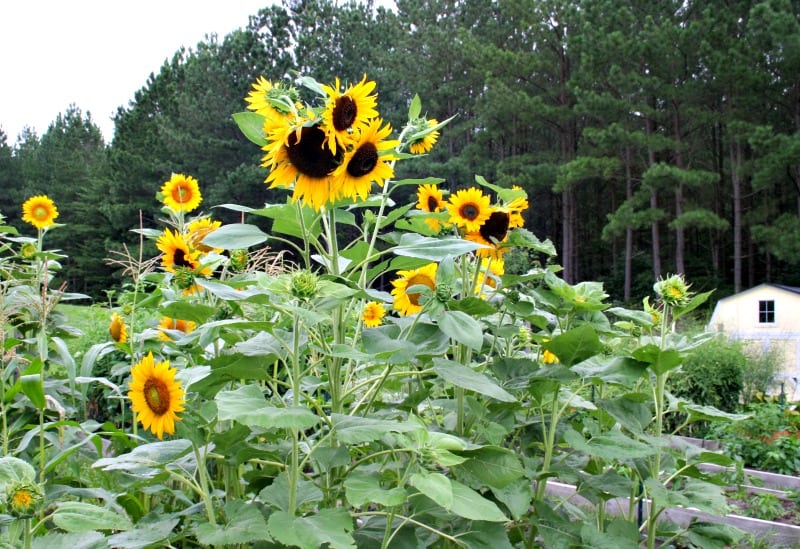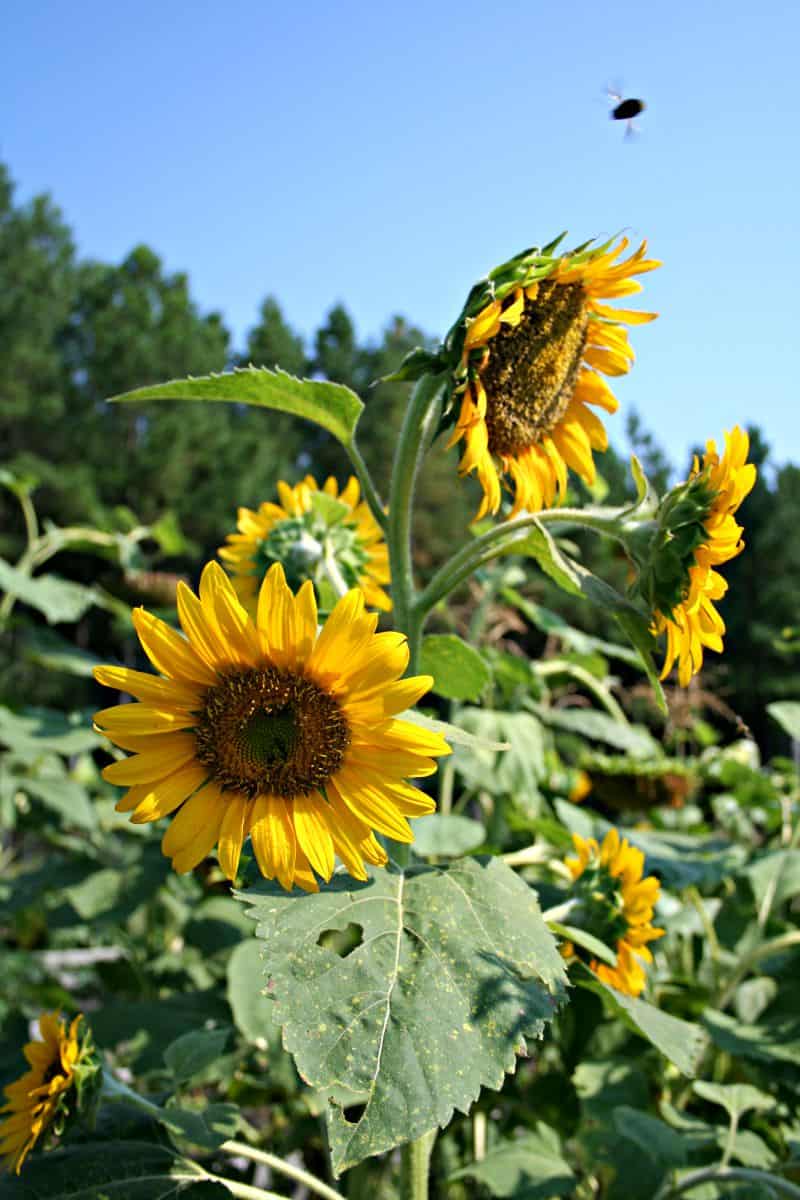Growing sunflowers is a tradition here at Seven Oaks Farm. Sunflowers are truly magnificent plants and now beloved additions to my garden every year.
I grow them for their beauty and to feed the birds; do you grow them? Do you eat the seeds or save them for the birds?

Growing Sunflowers (Helianthus annus)
Sunflowers (Helianthus annus) are one of the world’s most popular flowers, with sunflowers growing throughout North America, Europe and Russia. Helianthus annus or sunflower plants (sometimes spelled sun flowers) are native to North America. The Native Americans cultivated sunflowers for food and oil, eating the seeds raw, cooked, and pounded into a flour from which the oils and powder were mixed to create a cake or bread. When the Europeans arrived in the New World, the Spaniards recognized the value of the flowers and brought them back to Europe, where they grew readily. Most Europeans grew them as an ornamental flower until around 1700, when the English recognized the oils from sunflower seeds as a valuable cooking oil and a patent was issued for the extraction of sunflower oil. Sunflowers made their way throughout Europe and into Russia, where the Russians loved the easy to cultivate flower that provided both sustenance and oil. Soon, sunflowers became both a beloved and beautiful garden flower as well as a source of food for people and animals alike. Today, the National Sunflower Association represents the huge global market of buyers and farmers growing sunflowers for seeds, oils, commercial and other uses.

Sunflowers in the Garden
Most North American gardeners enjoy growing sunflowers purely for their ornamental value and beauty. They also make great additions to children’s gardens, and children love their towering, beautiful and sunny faces. Sunflowers must be planted in full sun. They prefer fertile, well-drained soil but will tolerate clay soil. Use only seeds sold in garden centers for garden use; sunflower seeds sold as snacks are heated, baked and salted, and will not germinate. Plant sunflower seeds after the last danger of frost is past. You might need to place a cloche or a clear, bell-shaped cover over the area until the sunflower plant has at least two sets of leaves. This isn’t so much to keep the plant warm as to keep hungry creatures such as chipmunks and squirrels from snacking on the sunflower seed itself. You can easily make a cloche from an old soda pop bottle. Wash, rinse, and remove the label. Cut it in half and use the half with the bottle top as a vent at the top to cover the plant until it is large enough to discourage hungry visitors.
Sunflowers can be plagued by various garden pests including grasshoppers and Japanese beetles. Although tattered leaves on sunflowers plants aren’t attractive, they usually don’t do the plant any harm.
Most gardeners choose a location next to a wall, fence or another support. As sunflowers grow taller and taller, they can get top heavy from the large, heavy sunflower head that makes them so beautiful and desirable. A wall, stake or support may be necessary to keep sunflowers from pulling over from the weight of the flower head.
Sunflowers offer many excellent properties, but one often overlooked is their ability to remove heavy metals and harmful toxins from the soil. They actually remove lead, arsenic, uranium, and cesium from the soil, and were planted near Chernobyl and now near Fukushima to reduce pollution from the nuclear disaster sites.
And no, it’s not your imagination; sunflowers really DO follow the course of the sun! The buds sense the sun and will gently turn to follow its track throughout the day. After the flowers fully mature and open, they remain facing East as if greeting the sun; truly, no other flower has ever been so aptly named as the sunflower or sunflower!
Enjoying Sunflowers and Sunflower Seeds
Sunflowers offer many uses, both practical and aesthetic:
- As a cut flower, grow many varieties including traditional yellow, golden, bronze and orange types
- Grow sunflowers to harvest and enjoy the seeds as a snack
- Cut flower heads, let them dry, then hang them from trees for natural bird feeders
If you do plan to enjoy sunflower seeds, you should remove the shells before eating the nutritious kernel inside. While not harmful to eat, the sharp edges can injure the intestines, and the National Sunflower Association reports that eating too many shells can cause intestinal impaction. So be sure to shell your sunflower seeds before enjoying them.
Sunflowers are not only gorgeous, they’re good for the environment. Sunflowers remain a worldwide non GMO crop as of this writing, so even if you’re concerned with organic gardening you can safely enjoy sunflowers. They are great for attracting birds to the garden, and for bird feeding. Grow them for beauty, to feed the birds or to simply enjoy them. Sunflowers offer nearly limitless possibilities!





Beautiful sunflowers. They are such hardy plants. Nice to hear they do such good things too. We have a gold finch that is enjoying some bugs off our sunflowers. I only have our native wild sunflowers growing (not the ones that make seeds we can eat). I let them self seed and have to remove the extras that creep into places where they won’t have room.